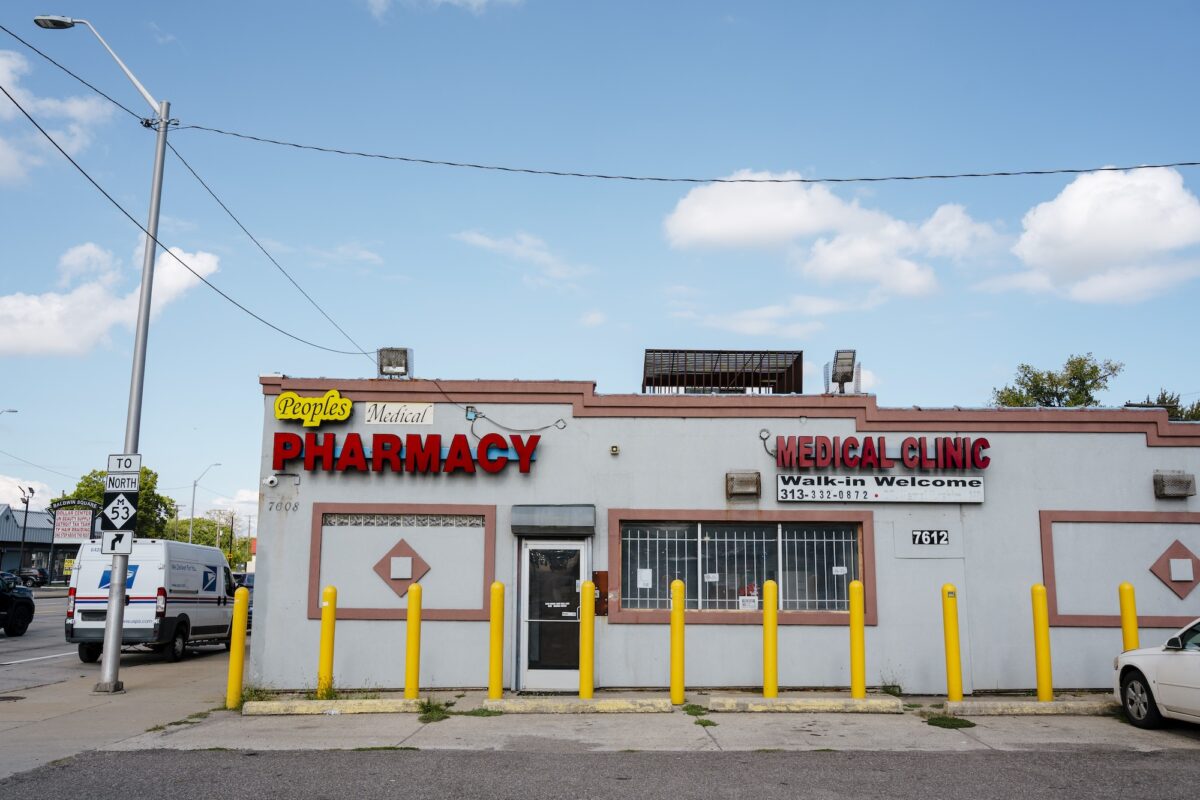Overview:
- In Detroit, transportation insecurity impacts 36% of residents, a figure that starkly contrasts with the national rate of 17%.
- This condition, where people struggle to travel safely and on time due to insufficient resources, is measured by the Transportation Security Index, developed by University of Michigan researchers. - The index highlights that 21% of Detroit households lack car access, and 71% of those without cars face transportation insecurity. With transportation costs consuming 19% of household budgets, the issue is intensified by steep car insurance rates, limited public transit, and escalating living expenses.
This story was produced as a project for the USC Annenberg Center for Health Journalism’s National Fellowship, with support from the National Fellowship Fund and the Dennis A. Hunt Fund for Health Journalism.
Alexandra Murphy noticed that transportation research followed a distinct pattern.
Engineers and urban planners would examine the man-made elements of a city—buildings, roads, bridges, parks, buses or trains—with a focus on neighborhoods or census tracts.

But another “profound” problem remained largely understudied, Murphy said, even among poverty researchers.
People who can’t afford to buy and repair a car, or even pay a $2 bus fare, can experience a hardship called transportation insecurity.
“It’s a condition in which an individual is unable to regularly get from place to place in a safe or timely manner because of an absence of resources for transportation,” Murphy said.
Along with her colleagues, Murphy, an assistant research scientist at Poverty Solutions at the University of Michigan, helped create a metric to describe the problem. The Transportation Security Index is a survey that poses a series of questions asking how often a person has experienced symptoms of transportation insecurity, such as rescheduling or skipping appointments or work because of a transportation problem within the past 30 days.
The index reveals that about 36% of Detroit residents are transportation insecure, according to a recent report co-authored by Murphy.
The index reveals that about 36% of Detroit residents are transportation insecure, according to a recent report co-authored by Murphy.
BY THE NUMBERS: TRANSPORTATION INSECURITY IN DETROIT
A recent University of Michigan report reveals the scope of transportation challenges facing Detroit residents:
• 36% of Detroit residents are transportation insecure—roughly twice the national rate of 17%
• 71% of Detroiters without cars experience transportation insecurity, compared to 27% of those with cars
• 56% of households earning less than $30,000 per year experience transportation insecurity
• 80% of transportation insecure residents struggle to pay for at least one transportation expense monthly
• 84% of transportation insecure Detroiters report feeling bad about not having the transportation they need
• 21% of Detroit households lack access to a car, compared to 7% statewide and 8% nationally*
• Transportation expenses account for 19% of yearly household budgets in Detroit, second only to housing**
* U.S. Census Bureau **Bureau of Labor Statistics
Forces that could worsen this trend include rising car prices and auto insurance costs. Other costs of living are also rising, and transit agencies are facing financial headwinds.
“I worry about what this means for people’s ability to get around, in combination with cuts to federal programs that might make people even more vulnerable,” Murphy said.
Murphy spoke with Planet Detroit about transportation insecurity in the city, the connections between transportation and health, and emerging solutions to address it.
The conversation has been edited for length and clarity.
Planet Detroit: How big a problem is transportation insecurity in Detroit?
Murphy: Most of the work we had done had been at the national level. No one had used it in a very local context. As it’s used more, we can put the Detroit numbers into context and compare them with other cities.
We found that more than one in three Detroiters experience transportation insecurity, a figure significantly higher than the nationwide rate.
The estimated prevalence of transportation insecurity in Detroit is considerably higher than national estimates. A 2022 national sample found that 17% of adults in the United States experienced transportation insecurity.
This suggests that transportation insecurity in Detroit is roughly twice the national level.
Who is experiencing transportation insecurity in Detroit?
Murphy: People who are unemployed. People who have a high school degree or less. People who live below the poverty line. Income is very much tied to insecurity. Also, people with disabilities, as well as children. These patterns parallel what we see at the national level.
Different from what we see nationally is that in Detroit, the difference between white and Black residents’ experience with transportation insecurity overall is not statistically significant.
At the same time, Black residents are significantly more likely to experience the most severe level of transportation insecurity 19%, high insecurity, compared to white residents at 11%. This suggests that racial inequality in transportation insecurity in Detroit manifests in the severity of insecurity instead of the experience of insecurity more generally.
We see nationwide that the younger you are, the more likely you are to experience transportation insecurity. We see that 46% of people aged 18 to 39 experience transportation insecurity. Contrast that with only 24% of people over 65. We need to study this a bit more.
Is it because younger people have more trips to take? Are seniors’ needs actually being met? There are many questions that need to be answered. Again, this is just preliminary work.
Why are some Detroiters transportation insecure?
Murphy: I can’t know from this data. This is not causal. It’s descriptive. But if you think about Detroit, there’s likely a number of things going on. We know that Detroit has exceptionally high car insurance rates. That alone makes affording a vehicle an extra cost burden. Public transit is sparse, and it’s not good regionally.
Being close to a bus stop does not tell us much about whether people are transportation insecure. The issue may be that the bus doesn’t take them where they need to go, or they need to go to the suburbs to get a job. We’d have to do a lot more work to understand those patterns better.
How does transportation insecurity affect people’s health?
Murphy: We know that transportation can be a barrier to getting to the doctor, getting follow-up care, and getting prescriptions filled.
The data show an association between transportation insecurity and self-rated health and physical and mental health. The more transportation insecure you are, the more you experience poor mental and physical health.
We had a study that found that transportation insecurity was among the leading forms of hardship, by numbers. It was as bad as food insecurity.
It’s important for us to think about the nexus between transportation and health. Transportation is vital for people to get to grocery stores where they can get fresh food and go to parks where they feel safe.
It’s important for people’s ability to get employment, which is good for their mental health and physical health.
If you have been feeling insecure about transportation for a very long time, you may spend a lot of time at home. Their mobility is very constrained. It’s very isolating.
People don’t get to see friends or family. When you can’t get around and have to rely on others, it can strain relationships in ways that are very stressful and detrimental.
The report said car owners can still be transportation insecure. Can you explain?
Murphy: Having a car is a buffer against transportation insecurity, but it doesn’t fully protect you from it.
In our research, we’ve met people with multiple cars, and all of them are down at any given time because they just can’t afford the repairs.
One thing that definitely drives this is the car-to-adult household ratio. If five adults in the house are of driving age and share one car, four people effectively don’t have the full freedom a car might offer. We see that shaping insecurity.
Whether people have suspended licenses or need repairs to their car, people will change their travel behaviors because it may not be worth it to drive to the store and get pulled over by police and get a ticket. But it may be worth it to drive to a job. Those people we would consider transportation insecure.
What can governments do to help residents with transportation needs?
Murphy: The food security index gave a name and a number to the problem, and people started saying, “Oh, we didn’t fully realize the extent of hunger in the US.”
We haven’t been able to quantify how many people are transportation insecure until now. I’m hoping those numbers allow people to have a conversation about this issue that isn’t just an add-on to other needs. It may not be enough to just think about schools and jobs—you have to think about how people get to these places.
The Department of Housing and Urban Development has housing vouchers. The U.S. Department of Agriculture has food stamps. The Department of Energy has energy assistance.
When you look at the Department of Transportation, there aren’t many individual programs.
One thing that’s very exciting is the idea of mobility wallets. It’s like food stamps for transportation. If we give people money for transportation-related expenses, they can get around better. Some mobility wallets let you use the same card for many different modes of transportation.
The way to address this is to build up infrastructure. Add more bus lines. But how do we help people use the transportation infrastructure that already exists?
Forces that could worsen this trend include rising car prices and auto insurance costs. Other costs of living are also rising, and transit agencies are facing financial headwinds.
“I worry about what this means for people’s ability to get around, in combination with cuts to federal programs that might make people even more vulnerable,” Murphy said.


